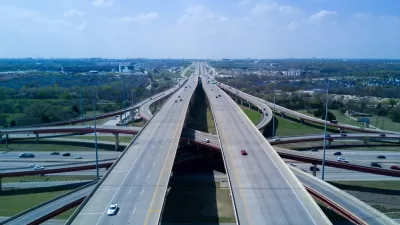Smart Growth America has released the "Measuring Sprawl 2014" report, which updates the 2002 report "Measuring Sprawl and Its Impact."

A new report by Smart Growth America, Measuring Sprawl 2014, analyzes development patterns in 221 metropolitan areas and 994 counties in the United States as of 2010 to produce several findings with relevance to the health outcomes of sprawling development patterns.
To produce the report’s sprawl index, “[researchers] used four primary factors—residential and employment density; neighborhood mix of homes, jobs and services; strength of activity centers and downtowns; and accessibility of the street network.”
“[The] report also examines how Sprawl Index scores relate to life in that community. The researchers found that several quality of life factors improve as index scores rise. Individuals in compact, connected metro areas have greater economic mobility. Individuals in these areas spend less on the combined cost of housing and transportation, and have greater options for the type of transportation to take. In addition, individuals in compact, connected metro areas tend to live longer, safer, healthier lives than their peers in metro areas with sprawl. Obesity is less prevalent in compact counties, and fatal car crashes are less common.”
Kris Hudson writes an article for the Wall Street Journal, first crediting the University of Utah research team behind the study, with a headline that focuses on two of the more obvious talking points of the report: car wrecks and obesity. Notably, Hudson begins the article by describing sprawl, its slowing rate, and allowing University of Utah Planning professor Reid Ewing to make the following proclamation: “[the report] tells us that the war on sprawl isn’t won yet…”
Hudson’s article, however, also concludes by quoting two dissenters among the academic and research communities, Harry Richardson and Wendell Cox, as well as a resident of Forsyth County who says the “advantages of living out here far outweigh” his commute.
Tanya Snyder also provides coverage of the report on Streetsblog USA, focusing on the rankings of metro areas and counties, as well as putting a fine point on the public health implications indicated by low index scores.
FULL STORY: Measuring Sprawl 2014

Maui's Vacation Rental Debate Turns Ugly
Verbal attacks, misinformation campaigns and fistfights plague a high-stakes debate to convert thousands of vacation rentals into long-term housing.

Planetizen Federal Action Tracker
A weekly monitor of how Trump’s orders and actions are impacting planners and planning in America.

San Francisco Suspends Traffic Calming Amidst Record Deaths
Citing “a challenging fiscal landscape,” the city will cease the program on the heels of 42 traffic deaths, including 24 pedestrians.

Defunct Pittsburgh Power Plant to Become Residential Tower
A decommissioned steam heat plant will be redeveloped into almost 100 affordable housing units.

Trump Prompts Restructuring of Transportation Research Board in “Unprecedented Overreach”
The TRB has eliminated more than half of its committees including those focused on climate, equity, and cities.

Amtrak Rolls Out New Orleans to Alabama “Mardi Gras” Train
The new service will operate morning and evening departures between Mobile and New Orleans.
Urban Design for Planners 1: Software Tools
This six-course series explores essential urban design concepts using open source software and equips planners with the tools they need to participate fully in the urban design process.
Planning for Universal Design
Learn the tools for implementing Universal Design in planning regulations.
Heyer Gruel & Associates PA
JM Goldson LLC
Custer County Colorado
City of Camden Redevelopment Agency
City of Astoria
Transportation Research & Education Center (TREC) at Portland State University
Jefferson Parish Government
Camden Redevelopment Agency
City of Claremont





























